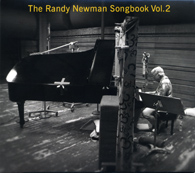Randy Newman
The Randy Newman Songbook Vol. 2
(Nonesuch)
2011 gave
Randy Newman a big present: an Academy Award (his Oscar #2) for his song
We Belong Together, from the Toy Story 3 soundtrack. Which is something
quite pleasant to receive (and of course he looked very happy, even though
both prizes were awarded after so many nominations), but which appears
to confirm the large gap existing between the esteem of those "in
the know", the "insiders", and the feedback he gets from
the audience at large.
Of course,
I can't say if there's link at work here, but just a few months after Newman
being awarded an Oscar - a mere eight years having passed since the release
of Vol. 1 - here's The Randy Newman Songbook Vol. 2. Which in a way makes
a lot of sense: to present Newman's music to those who heard his name for
the first time the moment he got his award.
As it
was the case with its predecessor, The Randy Newman Songbook Vol. 2 features
a slice of Newman's repertory just the way he performs it on stage, i.e.:
solo piano and vocals. The album was produced by familiar names Mitchell
Froom and Lenny Waronker, the latter being a childhood friend. Very well
recorded at Conway Studios, Los Angeles. Engineered by: David Boucher.
Mastered by world-famous master engineer Robert C. Ludwig, at his legendary
Gateway Mastering Studios. It's more or less the same recipe that made
Volume 1 such a(n artistic) success. After spending some time with both,
I have to say I've come to consider Vol. 2 as the superior specimen: While
both volumes present familiar pages - and those songs that in a sense have
to be featured - alongside a few curveballs, to me Vol. 2 appears to flow
more easily as a whole. At about 40', like an old LP, the album doesn't
overstay its welcome. The packaging is a bit on the spartan side, but there's
a booklet featuring all the lyrics, and the price is set at a price point
that won't discorage any exploratory impulses.
Let's
have a look at the setlist. There's a track off Newman's first album, simply
titled Randy Newman (Cowboy); three off 12 Songs (Suzanne, Lucinda, and
Yellow Man); two off Sail Away (Last Night I Had A Dream, and Dayton, Ohio
- 1903); two off Good Old Boys (Birmingham, and Kingfish); one each off
Little Criminals (Baltimore) and Born Again (The Girls In My Life, Part
1); two off Trouble In Paradise (Same Girl, and My Life Is Good); one each
off Land Of Dreams (Dixie Flyer) and Randy Newman's Faust (Sandman's Coming);
and two (Losing You, and Laugh And Be Happy) off his last studio album,
Harps And Angels (2008).
True,
when compared to the studio albums, the songs featured here lack the orchestra,
the rock group, the complex arrangements. But it's precisely their appearing "naked" that
makes these version show their compositional structure, while at the same
time highlighting Newman's vocal approach - so
"raw", yet so highly stylized - and the rich background of his
piano playing (and let's not forget their being so richly entwined, too).
Let's
talk about surprises. The first surprise (quite literally: it's track #1)
is having the chance to hear Dixie Flyer being performed on a real piano, producer Mark Knopfler's decision at the
time of recording the studio album Land Of Dreams being to feature the
Synclavier. The last surprise (also literally: it's the album's last track)
is hearing Cowboy being performed without the orchestra, but on the piano
- the instrument that had not been featured on the original version. Also
of interest, Newman's voice replacing Linda Ronstadt's on Sandman's Coming.
Those who love investigating subtleties are invited to compare Newman's
piano on Same Girl with Ralph Grierson's original performance.
It goes
without saying that the mix of styles is the one we know so dearly: echoes
of New Orleans piano, 40s Jazz, Ragtime, Blues, and Newman's personal exploration
of classical music. "Rolling" grooves, sophisticated chords.
Yellow Man, Suzanne, The Girls In My Life (Part 1), and King Fish inhabit
a land between Blues and Ragtime. Losing You and Sandman's Coming open
up melodically. At first, I was puzzled by this "naked" version
of My Life Is Good, given the fact that I'm so accustomed to listen to
the rich orchestration of the original ("Blow, Big Man!"), but I quickly
got to love this version. It's back to "rocking piano" with Birmingham
and Last Night I Had A Dream, which are followed by the touching Same Girl,
in my opinion one of the peaks of the album. A more "rock" feel
for Baltimore, it's Music Hall time for Laugh And Be Happy, it's back to
the Blues for Lucinda, with the melancoly, almost "period piece",
mood of Dayton, Ohio - 1903 to follow, with the already mentioned Cowboy
being a perfect close.
The
album proves without a doubt that Newman's repertory doesn't sound old,
his living outside of fashion making it practically impossible for one
to correctly date his songs. While his having been denied Big Money and
Fame makes it possible for him to play live without being confined to the
stifling role of The Human Juke_box - a chance many of his contemporaries
were not given, as a retribution for their financial wealth. As Harps And
Angels showed, the
"adult" Newman has not lost his creative verve. The future is yet
to come.
Beppe Colli
© Beppe Colli 2011
CloudsandClocks.net | May 19, 2011











